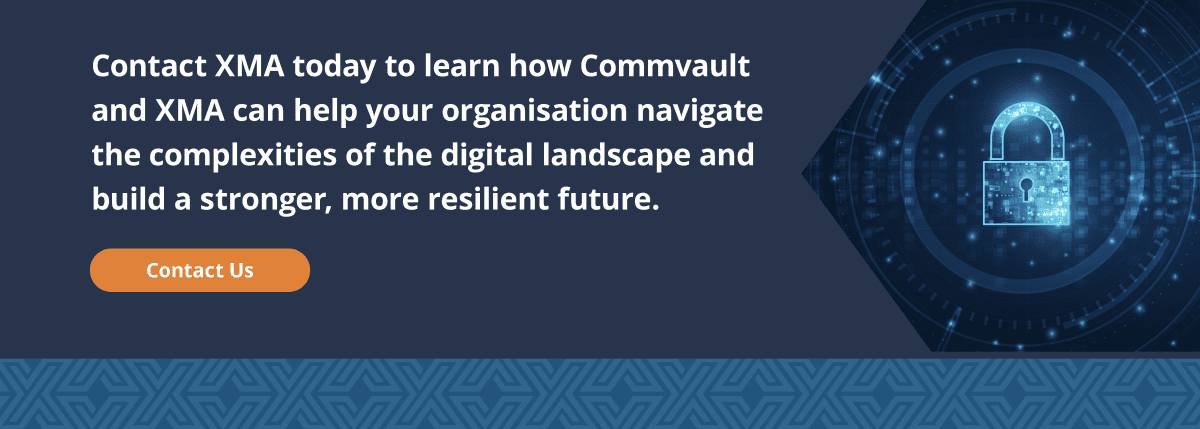In the ever-evolving digital landscape of 2024, cyber resilience is more than a technical concern – it’s a core business strategy. As threats grow more sophisticated, organisations must adapt to safeguard operations and data. XMA, in collaboration with Commvault, highlights the 5 critical trends and best practices shaping cyber resilience.
1: The Changing Face of Cybersecurity Leadership
The days of cybersecurity being solely an IT issue are over. Today, CEOs and board members are taking a more active role.
• Executive Involvement: Top-level executives are now directly involved in cybersecurity initiatives. This means they’re not just approving budgets but guiding strategic decisions and ensuring regulatory compliance. Boards that holistically understand cyber resilience are better equipped for the future.
• Strategic Decision-Making: Cybersecurity is no longer just about preventing breaches; it’s about aligning security strategies with broader business goals. Leadership plays a crucial role in this alignment.
“Security is about mindset, first and foremost, so it is vital that an organisation’s leadership team lead by example. As such, obtaining buy-in from the board and from line-of-business leaders is vital for a CISO to be effective.”
– Scott Wright, Head of Pre-Sales, XMA
2: Breaking Down Silos & The Power of Collaboration
• ITOps & SecOps Convergence: To effectively combat threats, it’s essential to break down the traditional barriers between IT operations (ITOps) and security operations (SecOps). This convergence allows for the sharing of threat intelligence and a more unified defence strategy.
• Shared Intelligence: When teams work together, threats can be detected earlier and responded to faster. This collaborative approach strengthens the overall security posture.
3: Harnessing AI & Automation for Defence
• Efficiency & Risk Mitigation: Artificial intelligence (AI) and automation are becoming indispensable tools in cyber resilience. They streamline threat detection and response, analyse vast amounts of data for anomalies, and automate routine tasks, freeing up human analysts for more complex challenges.
• The Balancing Act: While AI is a powerful ally, it’s crucial to recognise that cybercriminals are also using it. Organisations must develop balanced strategies that leverage AI’s benefits while mitigating its potential misuse.
“With AI-based tools for generating phishing emails and other attacks, AI-based defences are essential to combat the sharply rising numbers of never seen before attacks. The traditional
“try and match to a list of known malicious” approach is no longer fit for purpose. Some cybersecurity vendors embraced this years ago and are offering mature products capable of making highly reliable determinations on zero-day threats.”
-Scott Wright, Head of Pre-Sales, XMA
4: The Evolving Cybersecurity Skills Landscape
• Integrating Skills: The demand for professionals who can bridge the gap between AI and cybersecurity is on the rise. This integration is key to building robust defences against emerging threats.
• Continuous Learning: Cybersecurity is not a static field. Organisations must invest in continuous education and training to keep their teams equipped to handle the ever-changing threat landscape.
5: Testing, Clean Rooms, and Holistic Risk Management
• Regular Testing & Clean Rooms: Frequent testing of cyber defences, including the use of clean rooms (controlled environments for secure data recovery), is essential to ensure preparedness and the robustness of an organisation’s defences.
• Holistic Risk Management: Understanding digital risks is not just about technical vulnerabilities. It requires a comprehensive approach that integrates cybersecurity into every aspect of business operations.
“Incident response exercises are a crucial part of readiness testing. These exercises can range from a half-day for a small group to a week-long exercise involving representatives from all areas of the organisation. There are always great lessons learned!” –Scott Wright, Head of Pre-Sales, XMA
Commvault: The Solution for Cyber Resilience
Commvault’s comprehensive solutions help organisations build a resilient digital infrastructure. By embracing the trends and strategies like the ones above, businesses can achieve greater continuity and security in the face of evolving threats.
Ready to Strengthen Your Cyber Resilience?













 Monitoring by Hotjar
Monitoring by Hotjar